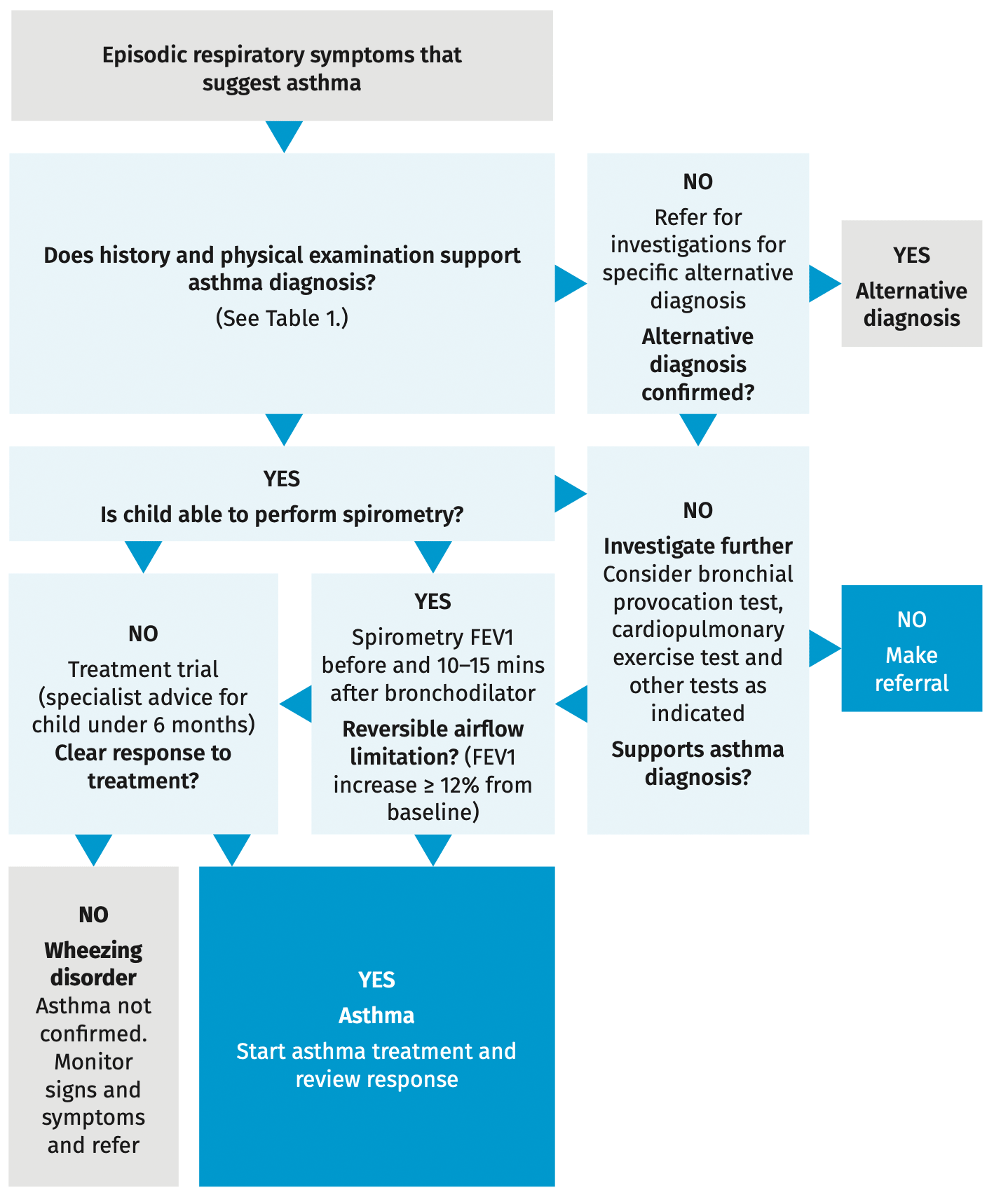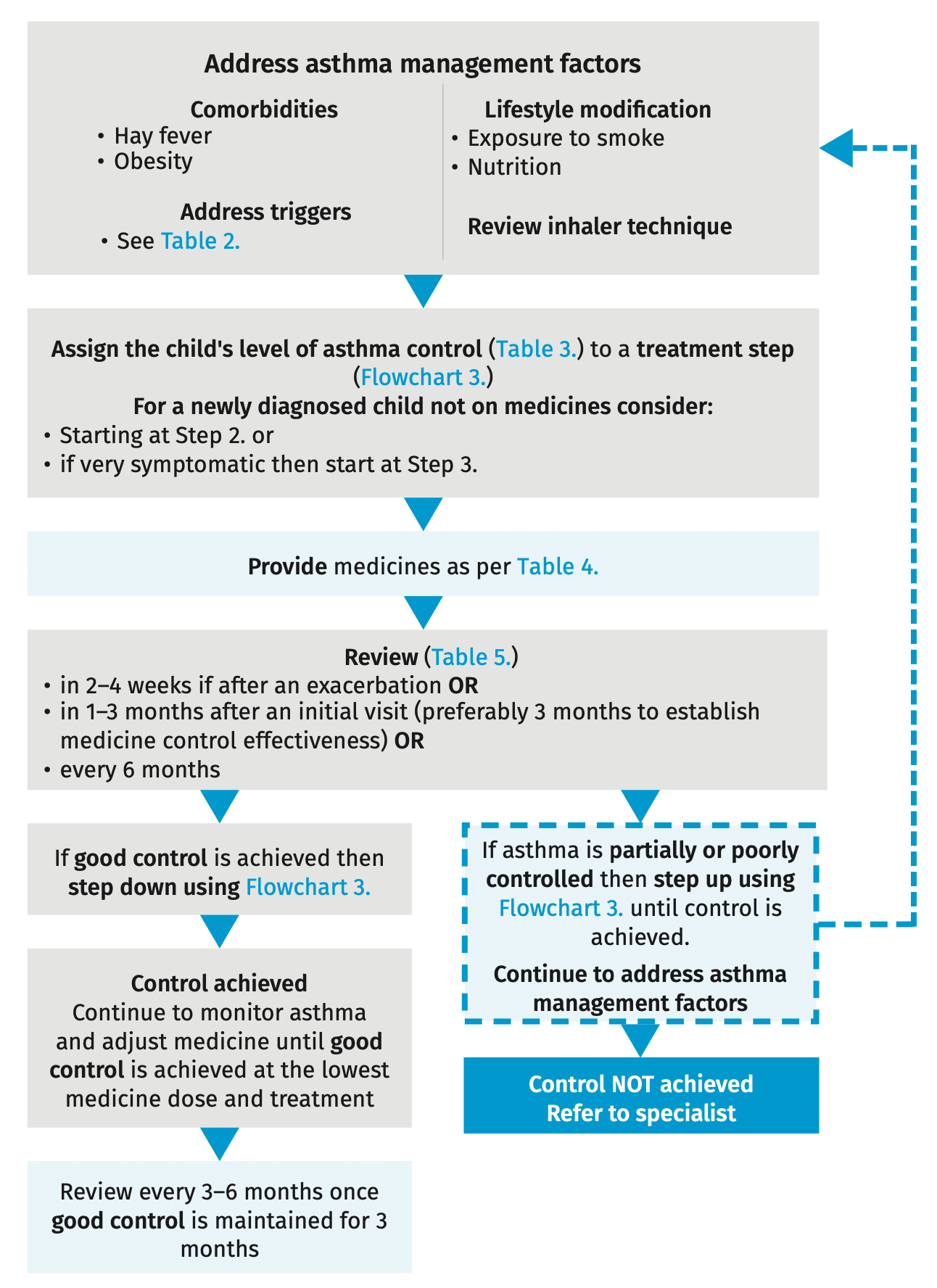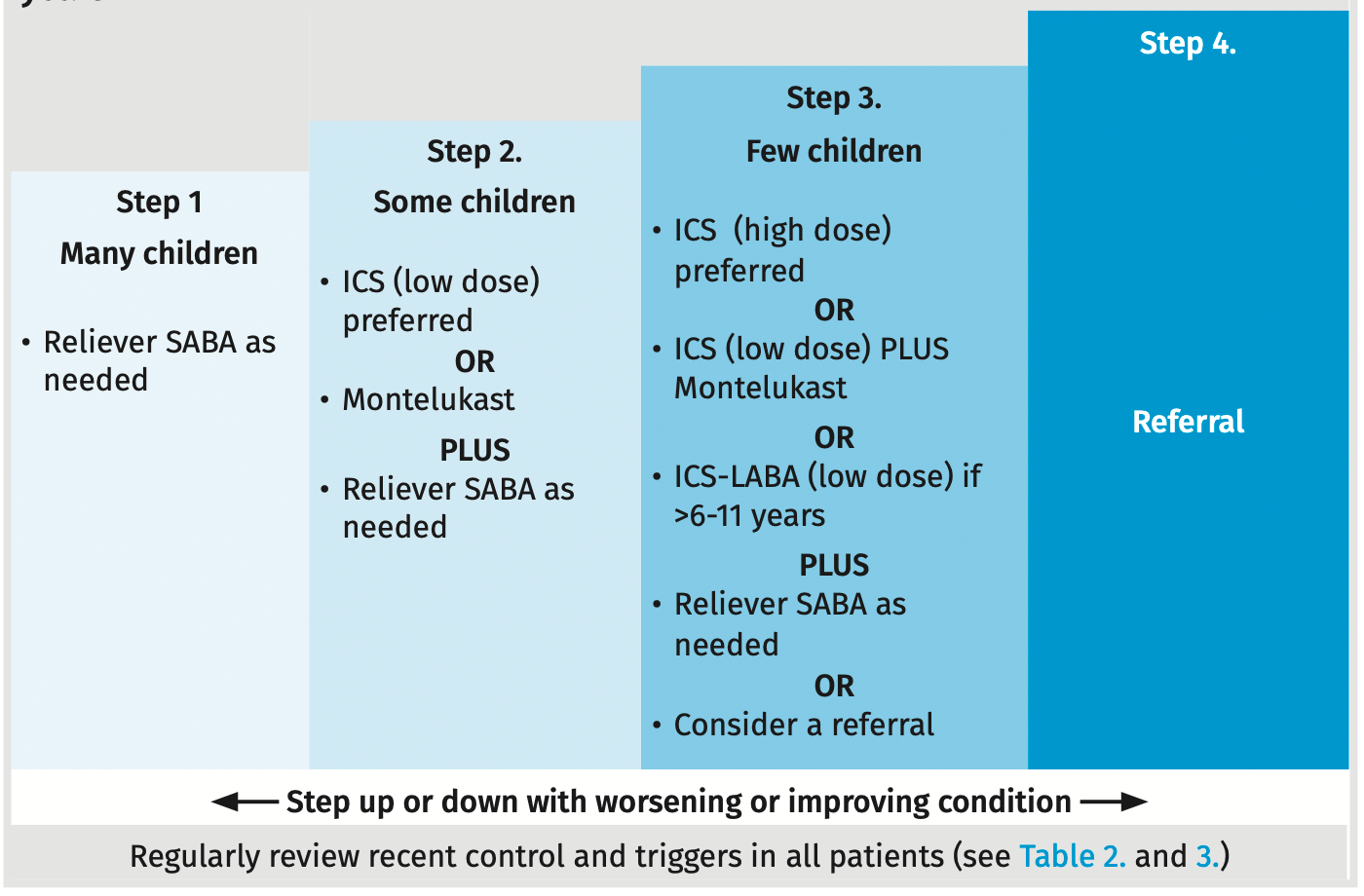High risk groups 1,2
- Children 1–12 years with a diagnosis of asthma
- Children 1–12 years who are exposed to asthma triggers. See Table 2.
Urgent referral
- For an acute asthmatic episode see the Primary Clinical Care Manual
- All infants < 12 months with a clinically significant wheeze should be reviewed urgently by an MO/NP
Special considerations
- A prior diagnosis of asthma should be corroborated by documented evidence
1. What is asthma? 1–4
- See Asthma (adults and children > 12)
2. Diagnosis of asthma in children 1–12 years 1–4
- In children, asthma diagnosis is based primarily on:
- history of recurrent or persistent wheeze
- presence of allergies or family history of asthma and allergies
- absence of physical findings that suggest an alternative diagnosis
- tests that support the diagnosis
- a consistent clinical response to an inhaled bronchodilator or preventer
- Diagnosing children with asthma is difficult because:
- spirometry can be difficult
- respiratory symptoms such as cough and wheeze are common
- those who respond to inhalers often do not have asthma when older
- Table 1. outlines findings that increase or decrease the likelihood of asthma
Table 1. Findings that increase or decrease the probability of asthma in children 1–12 years | |
|---|---|
Asthma more likely | Asthma less likely |
More than one of these symptoms
| Any of
|
AND | |
Any of
| |
Adapted with permission from the Australian Asthma Handbook, Version 2.2 © 2022 National Asthma Council Australia. | |
- Alternative causes of a recurrent wheeze in children may include:
- lower (infants) and upper (older children) viral respiratory tract infections
- aspirate (reflux)
- inhaled foreign body
- rhino-sinusitis
- tuberculosis
- cystic fibrosis
- bronchopulmonary dysplasia
- congenital malformation of the airways
- immune deficiency
- congenital heart disease
- Flowchart 1. illustrates the steps to confirm an asthma diagnosis in children under 12
Flowchart 1. Steps to diagnosing asthma in children 1–12 years

Adapted with permission from the Australian Asthma Handbook, Version 2.1. © 2020 National Asthma Council Australia.
3. Management of children 1–12 years with asthma 1–4,6,7
- The goals of managing asthma are to:
- engage the child and parent/carer to identify asthma management goals
- minimise impact of asthma on quality of life
- optimise asthma symptom control with minimal medicines
- minimise risk of exacerbations and loss of lung function
- minimise adverse effects of treatment
- identifying and managing comorbid conditions including:
- hay fever; common in children and associated with poor asthma control
- Overweight and obesity (child)
- Support child self-management 8
- See Lifestyle modifications with particular attention to Smoking cessation and Diet and nutrition
- Provide culturally appropriate resources about asthma and support services. See Resource 1.
- In partnership develop an asthma action plan (Resource 2.) identifying:
- asthma triggers. See Table 2.
- symptoms that indicate asthma is worsening
- actions to take when symptoms worsen
- when and how to use medicines and correct inhaler use. See Resource 3.
- doses and frequencies of regular medicines
- how to adjust treatment in response to particular signs and symptoms
- when to start oral corticosteroids
- when and how to seek urgent medical help
- At each visit the asthma action plan should be reviewed and adjusted as required
- Patients who accept their asthma symptoms as normal, require added support to show that symptoms and quality of life will improve with correct medicine use, lifestyle modification and regular monitoring. See Resource 1.
- Encourage the patient to identify barriers to adequate lifestyle modification and
medical adherence and create goals to overcome those barriers. See Engaging our patients
- Social-emotional support 3,8
- Parents/carers of children with chronic conditions experience high levels of stress and anxiety
- See Social-emotional wellbeing
Table 2. Summary of asthma triggers for children 1–12 years | |
|---|---|
Avoidable triggers | Unavoidable triggers |
Always avoid | Do not avoid |
|
|
Avoid or reduce if possible | Manage |
Allergens
Airborne/environmental irritants
Certain medicines
Dietary triggers
| Respiratory tract infections Certain medicines (requires close specialist supervision)
Comorbid medical conditions
Physiological and psychological changes
|
Adapted with permission from the Australian Asthma Handbook, Version 2.1. © 2020 National Asthma Council Australia | |
- Avoiding cigarette smoke 1,3,4
- Being subjected to cigarette smoke is a primary trigger for developing and exacerbating asthma symptoms in children
- Be mindful of the parent/carer smoking behaviour and frequency when assessing a child's recent asthma symptom control
- Reinforce the dangers of passive smoking, particularly in homes and cars
- Regularly encourage the parent/carer to quit smoking. See Smoking cessation
- Nutrition 1,2
- Weight reduction in overweight or obese children reduces asthma symptoms. Consider a referral to a dietitian
- The risk of asthma exacerbations is reduced in those who have a diet high in fresh fruit and vegetables and oily fish
- A diet high in processed foods and soft drink increases the risk of developing asthma
- See Diet and nutrition
- Child asthma control
- Ascertain the child's recent level of asthma symptom control using Table 3.
- Recent asthma symptom control is based on symptoms over the previous 4 weeks
- When counting the times a child uses their reliever puffer, do not include times taken before exercise
Table 3. Definition of levels of recent asthma symptom control in children 1,3 | |||
|---|---|---|---|
In the past 4 weeks, has the child had | Well controlled | Partly controlled | Poorly controlled |
Children 6–11 years
| None of these | 1–2 of these | 3 or more of these |
Children 1–6 years
| |||
Sample questions for reviewing asthma control in children
| |||
4. Medicines for children 1–12 years with asthma 1,3,4
- Use Flowchart 2. to determine optimal medicine use for the child with asthma
- Medicines should be reviewed by the MO/NP or pharmacist according to child's response and current condition
Flowchart 2. Intervention to achieve asthma control

- rect inhaler use 3
- Regular Inhaler and spacer use technique should be demonstrated, taught and monitored in this age group. See Resource 3.
To reduce adverse effects and increase delivery to the airways, when using inhaled medicines, children:
- < 4 years should use a pMDI plus a spacer with face mask
- > 4 years should use a pMDI plus spacer with a spacer mouthpiece
- SABA should only be used at the lowest dose and frequency required if:
- asthma symptoms occur (e.g. wheezing or breathlessness)
- before exercise for those with known exercise induced asthma
- Medicine precautions in asthma 1,3,5
- Any newly obtained medicines (prescriptions, over the counter or complimentary) should be checked for asthma trigger risk. See Table 2.
- Sedatives are contraindicated during an acute asthma episode
Flowchart 3. Stepped approach to adjusting asthma medicine in children 1–12 years 2,3,9

Table 4. Medicines for children 1–12 years with asthma 1,3,4,9 | |
|---|---|
SABA (reliever) | |
Salbutamol (pMDI) 100 microgs (1-2 puffs) inhaled PRN Terbutaline (DPI) 500 microgs (1 puff) inhaled PRN. Only for use in children < 8 years |
|
*LTRA (preventer)2–12 years only | |
Montelukast (chewable tablet)
|
|
ICS (preventer)
| |
Beclometasone dipropionate (MDI)
|
|
Budesonide (DPI)
|
|
Fluticasone propionate (pMDI and DPI)
| |
ICS–LABA (preventer 6–11 years)
| |
Fluticasone propionate and salmeterol (Seretide®)
| |
*See LAM and PBS for medicine indications and restrictions | |
- Medicine review 3
- Children should be reviewed:
- 2–4 weeks after an exacerbation OR
- 1–3 months after an initial visit with preference given to 3 months to ascertain the medicines effectiveness to control the asthma OR
- every 6 months
- If a child's asthma is poorly controlled within 1–3 months step up treatment
- If good controlis achieved for 6 months then stepdown treatment to the least
medicine required to maintain control - Ongoing monitoring is necessary every 3–6 months once good control is achieved so that adjustments can be made in response to worsening symptoms or episodes of exacerbations
- Children should be reviewed 3–6 weeks after asthma therapy has been discontinued to assess for residual symptoms
- Overuse of SABA requires review as this is a sign of poor control
- Children should be reviewed:
Table 5. Reviewing and adjusting asthma preventer treatment for children 1–12 years 1,3,4,9 | |||
|---|---|---|---|
Treatment | Review | Treatment response | |
Good | None | ||
SABA | 4 wkly |
|
Step up
|
ICS (low dose) | 4 wkly |
|
Step up
|
ICS (high dose) or ICS (low dose)plus LTRA | 4 wkly |
|
Refer for specialist review |
5. Cycle of care
Cycle of care summary for children 1–12 years with asthma | ||||
|---|---|---|---|---|
Action | Dx | Good control | Partial control | Poor control |
Height | 3 mthly until 2 years of age for high risk groups otherwise as per child health check | |||
Weight | As above | |||
Inhaler technique | 12 mthly | 6 mthly | 3 mthly | |
Spirometry | 12 mthly | 6 mthly | 3 mthly | |
Social-emotional wellbeing | 12 mthly | 6 mthly | 3 mthly | |
Lifestyle modification | 12 mthly | 6 mthly | 3 mthly | |
Self-management education | 12 mthly | 6 mthly | 3 mthly | |
Asthma action plan and asthma first aid | At each visit | |||
Symptom review | 4 wkly or when changing medicines | |||
Medication review | ||||
MO/NP review | 12 mthly | 6 mthly | 3 mthly | |
RN/IHW review | 12 mthly | 6 mthly | 3 mthly | |
Specialist MO | Any uncontrolled or difficult to treat asthma Any child under 2 years of age requiring a SABA | |||
Influenza, pneumococcal, pertussis and covid vaccines | Recommended. See the Australian Immunisation Handbook for the schedule | |||
Comorbidity management | Each time child is assessed for asthma control | |||
6. References
- All Chronic Conditions Manual references are available via the downloadable References PDF